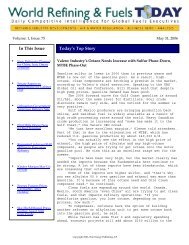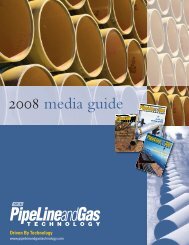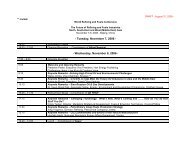ASTM: Gasoline Today and Tomorrow – An Executive Report
ASTM: Gasoline Today and Tomorrow – An Executive Report
ASTM: Gasoline Today and Tomorrow – An Executive Report
Create successful ePaper yourself
Turn your PDF publications into a flip-book with our unique Google optimized e-Paper software.
Octane Week | <strong>ASTM</strong>: <strong>Gasoline</strong> <strong>Today</strong> <strong>and</strong> <strong>Tomorrow</strong> - <strong>An</strong> <strong>Executive</strong> <strong>Report</strong><br />
Ethanol, Oil, Autos Ready for Ethanol Sulfate Round Robin<br />
This story appeared in January 2006.<br />
Ethanol, oil <strong>and</strong> auto companies are fast-tracking<br />
a round robin that will evaluate three test methods for<br />
determining sulfate concentrations in ethanol. Fuel<br />
samples have been prepared <strong>and</strong> are to be delivered<br />
in January to the labs participating in the effort, which<br />
has alternatively engendered cooperation <strong>and</strong> sparked<br />
tension among the representatives.<br />
Dispute over test methods nearly scuttled an<br />
agreement to set a 4 ppm sulfate limit in D-4806, <strong>ASTM</strong>ʼs<br />
ethanol specification. After a fierce test method debate<br />
at <strong>ASTM</strong>ʼs recent winter meeting, oil, ethanol <strong>and</strong> auto<br />
industry representatives agreed to initiate a round robin<br />
this month with the aim of establishing a 4 ppm ethanol<br />
sulfate specification later this year.<br />
The Renewable Fuels Association (RFA) has<br />
endorsed the new specification <strong>and</strong> is encouraging their<br />
membership to do the same.<br />
“The cooperation between automakers, gasoline<br />
marketers <strong>and</strong> ethanol producers in supporting this<br />
specification demonstrates that all facets of the gasoline<br />
industry underst<strong>and</strong> the need for such a specification to<br />
protect their mutual customers,” said Citgo Petroleumʼs<br />
Dave Harvey, who has spearheaded the effort within<br />
<strong>ASTM</strong>.<br />
“With new federal legislation requiring increased<br />
use of ethanol as a component of automotive fuel, it<br />
is important to ensure that gasoline blend components<br />
conform to stricter st<strong>and</strong>ards, thereby providing the<br />
motoring public with a continued reliable energy<br />
source.”<br />
Although most ethanol producers do endorse a 4<br />
ppm sulfate limit, few supported the lead potentiometric<br />
titration test that had seemed so promising. Ethanol<br />
industry representatives attending <strong>ASTM</strong>ʼs December<br />
meeting blasted the method, but their objections were<br />
not sufficient to halt the entire “ballot,” the method<br />
<strong>ASTM</strong> uses to determine member support for changing<br />
or adopting specifications. The ballot to add a 4 ppm<br />
sulfate limit to D-4806 passed the D02.A subcommittee<br />
on gasoline <strong>and</strong> will be sent to the full D02 Committee<br />
in time for results to be available at <strong>ASTM</strong>ʼs June<br />
meeting.<br />
To resolve the test method grievances, the D03.03<br />
subcommittee on elemental analysis will conduct a<br />
round robin on three sulfate detection test methods <strong>–</strong> the<br />
lead titration method <strong>and</strong> two ion chromatography (IC)<br />
procedures. There too, the aim is to have test method<br />
results back in time for possible approval of both spec<br />
<strong>and</strong> test method at the next D02 meeting, which is<br />
scheduled for June.<br />
“The round robin will get started next week,” a<br />
source close to <strong>ASTM</strong> told Octane Week. “Fuel samples<br />
have been obtained <strong>and</strong> prepared.”<br />
Although the timetable is very short, the schedule<br />
should leave room for statistical analysis, which is<br />
central to the precision statement, the source said.<br />
Assuming the 4 ppm ballots with test method pass<br />
the appropriate <strong>ASTM</strong> committees in June, when might<br />
the spec take effect? “Sometime in the fall,” <strong>ASTM</strong><br />
members say, but the exact timing depends on the<br />
date of publication, which can be several months after<br />
committee approval.<br />
That doesnʼt leave much time for ethanol producers<br />
to make plant modifications if any are needed to meet<br />
the new specification. A survey of ethanol producers<br />
revealed several plants produced ethanol containing<br />
more than 4 ppm sulfate.<br />
“If the spec takes effect in October, thatʼs only<br />
nine months for producers to design, build <strong>and</strong> install<br />
equipment if more than a process change is needed.<br />
Earlier is worse,” the source continued.<br />
The ballot faces its toughest test of support at<br />
the D02 Committee, where new ethanol producermembers<br />
will be voting in June. If the spec <strong>and</strong> the<br />
test method donʼt satisfy that growing population of<br />
<strong>ASTM</strong> members, the weight of their votes could spell<br />
trouble for the “unprecedented display of industry-wide<br />
cooperation” marshaled by Citgoʼs Harvey.<br />
<strong>–</strong> Carol Cole<br />
12 February 2007
















